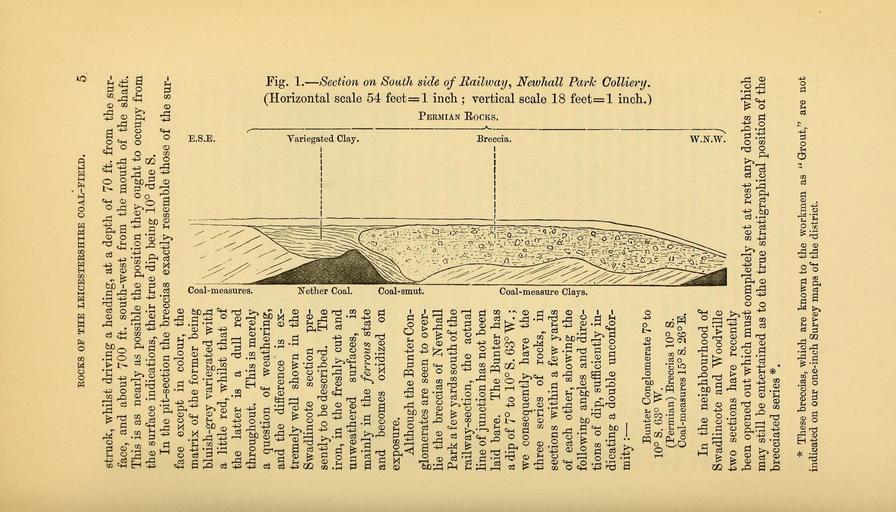MAKE A MEME
View Large Image

| View Original: | The_Quarterly_journal_of_the_Geological_Society_of_London_(13959994793).jpg (2100x1200) | |||
| Download: | Original | Medium | Small | Thumb |
| Courtesy of: | commons.wikimedia.org | More Like This | ||
| Keywords: The Quarterly journal of the Geological Society of London (13959994793).jpg ROCKS OE THE LEICESTERSHIRE COAL-FIELD 7 <br> able denudation prior to the deposition of the Bunter and that the <br> phenomena cannot be explained by contemporaneous erosion This <br> section in fact exhibits in a very beautiful manner a double uncon- <br> formity and clearly proves that we may without doubt refer the <br> series of strata to which the Breccias belong to the Permian ; for <br> they are not stratigraphically connected either with the Carboniferous <br> or with the Trias <br> Swadlincote fig 3 and PI I ” The stratigraphical break between <br> the Permians of the Leicestershire Coal-field and the Trias is still <br> more strikingly evidenced by an exposure in an open-working at <br> Swadlincote about 1 mile north-west of the section last described <br> The pit has been excavated for the purpose of procuring fire-clay <br> and is 750 yards south-east of Swadlincote Station This is the <br> exposure referred to by Mr W S Gresley F G S in his paper On <br> the Occurrence of Possiliferous Haematite Nodules in the Permian <br> Breccia of Leicestershire ' Midland Naturalist ' vol ix 1886 <br> The ridge of ground on the side of which the pit is situated is <br> correctly shown on the one-inch Survey maps as an outlier of Bunter <br> Conglomerate The magnificent section is from 70 to 80 ft <br> in height and shows about 8 ft of horizontally bedded Bunter <br> Conglomerates of the usual type of the district resting upon about <br> 26 ft of Permian beds made up of sandstones breccias and marls <br> The Permians together with the underlying Coal-measure clays and <br> their associated coal-seams dip into the side of the hill at an angle of <br> 23° in a direction N 50° E so that the unconformity between the <br> Trias and the underlying beds is most striking <br> That there is any great break between the Coal-measures and <br> the Permian in this section is not very apparent at first sight as <br> both seem to dip at the same angle of 23° ; but since the section is <br> almost along the line of strike it is possible that there may be a little <br> discordance of dip which is not evident in the present state of the <br> excavation The unconformity in this case is however indicated <br> clearly by the abrupt change in the lithological characters of the <br> beds and by the occurrence at the line of junction of an eroded <br> and impersistent bed of hard fine-grained Coal-measure sandstone <br> cank <br> The following are details of the section as taken in July 1886 ; <br> but since that time the face of the excavation has been carried some <br> yards further into the hill thus exposing a considerable thickness of <br> Lower Keuper Sandstones and Marls above the Bunter Conglomerate <br> besides showing a considerably greater thickness of Permian and <br> rendering still more evident the distinct break between this series <br> of rocks and the Coal-measures 36939802 113696 51125 Page 5 Text 45 http //www biodiversitylibrary org/page/36939802 1889 Geological Society of London Biodiversity Heritage Library The Quarterly journal of the Geological Society of London v 45 1889 Geology Periodicals Smithsonian Libraries bhl page 36939802 dc identifier http //biodiversitylibrary org/page/36939802 smithsonian libraries Information field Flickr posted date ISOdate 2014-04-21 Check categories 2015 August 26 CC-BY-2 0 BioDivLibrary https //flickr com/photos/61021753 N02/13959994793 2015-08-26 06 53 56 cc-by-2 0 PD-old-70-1923 The Quarterly journal of the Geological Society of London 1889 Photos uploaded from Flickr by Fæ using a script | ||||